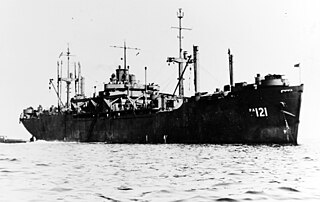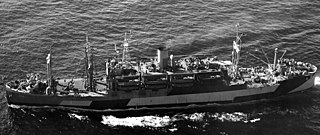
USS Storm King (AP-171) was a Storm King class auxiliary transport of the United States Navy. She was designed as a troop carrier, and named after Storm King Mountain.

USS Aquarius (AKA-16) was an Andromeda-class attack cargo ship in the service of the United States Navy. She was named after the constellation Aquarius. She was one of a handful of World War II AKAs manned by officers and crew from the United States Coast Guard. She served as a commissioned ship for 2 years and 9 months.

USS Haskell (APA-117) was the lead ship of her class of attack transports, built for the United States Navy during World War II. She was of the VC2-S-AP5 Victory ship design type. Haskell was named for the Haskell Counties of Kansas, Oklahoma, and Texas.

USS Electra (AKA-4) was an Arcturus-class attack cargo ship named after Electra, a star in the Pleiades star cluster in the constellation Taurus. She served as a commissioned ship for seven years.

USS Highlands (APA-119) was a Haskell-class attack transport built and used by the US Navy in World War II. She was a Victory ship design, VC2-S-AP5. She was named after Highlands County, Florida, United States.

USS Hocking (APA-121) was a Haskell-class attack transport in service with the United States Navy. from 1944 to 1946. She was scrapped in 1974.

USS Missoula (APA-211) was a Haskell-class attack transport in service with the United States Navy from 1944 to 1946. She was scrapped in 1975.

USS Bolivar (APA-34) was a Bayfield-class attack transport in service with the United States Navy from 1943 to 1946. She was then sold into commercial service and was scrapped in 1973.
USS LST-850 was an LST-542-class tank landing ship built for the United States Navy during World War II. Late in her career, she was renamed Juniata County (LST-850)—after Juniata County, Pennsylvania, the only U.S. Naval vessel to bear the name—but never saw active service under that name.

USS Lamar (APA-47) was a Bayfield-class attack transport in service with the United States Navy from 1943 to 1946. She was sold into commercial service in 1948 and was scrapped in 1971.

USS Latimer (APA-152) was a Haskell-class attack transport in service with the United States Navy from 1944 to 1947 and from 1950 to 1956. She was scrapped in 1972.

USS Mendocino (APA-100) was a Bayfield-class attack transport that served in the United States Navy from 1944 to 1946. In 1947, she was sold into commercial service and was scrapped in 1973.

USS Leon (APA-48) was a Bayfield-class attack transport in service with the United States Navy from 1944 to 1946. She was sold into commercial service in 1947 and was scrapped in 1971.

USS Knox (APA-46) was a Bayfield-class attack transport in service with the United States Navy from 1944 to 1946. in 1947, she was sold into commercial service and was finally scrapped in 1971.

USS Windsor (APA-55) was a Windsor-class attack transport in service with the United States Navy from 1943 to 1946. She was scrapped in 1972.

USS Pierce (APA-50) was an Ormsby-class attack transport that served with the US Navy during World War II.

USS Sheridan (APA-51) was an Ormsby-class attack transport that served with the US Navy during World War II.

USS Harris (APA-2) was an Emergency Fleet Corporation Design 1029 ship launched for the United States Shipping Board (USSB) on 19 March 1921 by Bethlehem Shipbuilding Corporation, at Sparrows Point, Maryland as Pine Tree State. After operation by commercial lines for the USSB, during which the ship was renamed President Grant and operated commercially until laid up in the late 1930s.

USS J. Franklin Bell (APA-16) was a Harris-class attack transport ship. She was built in 1921 and spent 20 years in merchant service as a passenger and cargo liner. She was acquired for the United States Army in 1940 and transferred to the United States Navy shortly after the USA entered the Second World War. She served throughout and after the Pacific War, was decommissioned in 1946 and scrapped in 1948.

USS George Clymer (APA-27) was an Arthur Middleton-class attack transport that saw service with the US Navy in four wars - World War II, the Chinese Civil War, the Korean War and the Vietnam War. It was named after United States Founding Father George Clymer.




















